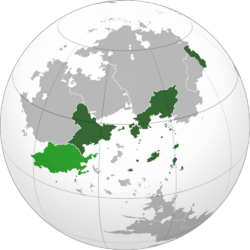Vestric Forum: Difference between revisions
| Line 147: | Line 147: | ||
| style="text-align:center" | 10,293 | | style="text-align:center" | 10,293 | ||
|5 | |5 | ||
| style="text-align:center" | | | style="text-align:center" | | ||
|- | |- | ||
Revision as of 12:26, 10 May 2020
This article is incomplete because it is pending further input from participants, or it is a work-in-progress by one author. Please comment on this article's talk page to share your input, comments and questions. Note: To contribute to this article, you may need to seek help from the author(s) of this page. |
|
Flag | |
 Member states Suspended member states Former member states | |
| Demonym(s) | |
| Type | Continental union |
| Membership | |
| Leaders | |
| vacant | |
| vacant | |
| Legislature | Vestric Parliament |
| Establishment | |
| 8 September 1999 | |
| Area | |
• | 32,888,655 km2 (12,698,381 sq mi) |
The Vestric Forum (VF; Veleaz: Fòrum Vestrico, FV.) is an intergovernmental regional organization. The most important decisions of the VF are made by the Assembly of the Vestric Forum, a semi-annual meeting of the heads of state and government of its member states.
The Vestric Forum's purpose is to promote itself as a Vestric coordination mechanism for public policies, in defense of democracy, republicanism, the independence of powers, social liberty, with sustainability and with due application
Overview
At the Fourth Vestric Summit on 8 September 1999, presidents or representatives from various Vestric nations signed the Jutosa Declaration, a two-page statement of intent announcing the foundation of the Vestric Forum.
The primary objectives of the Vestric Forum are the following:
- To promote a peaceful coexistence for the nations of the continent.
- To promote democratic governance and popular political participation.
- To promote and protect human rights to the forum's standards as well as other relevant international bodies.
- To promote the development of the continent to allow it to wield equitable influence in international economic or political matters.
- To promote sustainable and integrated development of Vestric economies.
- To advance the continent's scientific and technological research capacity.
The Vestric Forum is made up of both political and administrative bodies. Ultimately, political decision making power within the Vestric Forum lies with the heads of state of the members of the organisation. The various heads of state of the Forum meet from time to time at the Forum Assembly, in which various issues surrounding the organisation and its member states are discussed. The Forum's representative body is known as the Vestric Parliament, which contains members elected by the national legislatures of the Vestric Forum's member states. Each member state sends a delegation of parliamentarians based on a proportion of their population to the Parliament. The composition of the delegation should reflect the political diversity of the member state's legislature.
Member States
| Arms | Flag | State | Capital | Code | Accession | Population | Area (km2) | MVPs | Notes |
|---|---|---|---|---|---|---|---|---|---|
| Isolaprugna | Costapunente | IS | 3,102,000 | 10,293 | 5 | ||||
| Ovandera | Vannerr | OV | 2001 | 115,640,000 | 920,743 | 0 | Suspended | ||
| Skjoldeland | Rjuvik | SJ | 2001 | 23,832,107 | x | 12 |
| ||
| Totals: | 3 countries | 69,915,107 | 38 |
Politics
The Vestric Forum functions on a system of both supernational and intergovernmental coordination, and according to the rules of principle cooperation, any areas of policy not explicitly agreed in treaties by all member states remain the domain of the member states.
The Vestric forum has 5 main principal decision-making bodies, its institutions: Assembly of the Vestric Forum, The Vestric Parliament, the Vestric Executive the Vestric Inquiry, and the Vestric Court of Justice. Competence in scrutinising and amending legislation is shared between the Assembly of the Vestric Forum and the Vestric Parliament, while executive tasks are performed by the Vestric Executive office. Application of Vestric law and its treaties are carried out by the Vestric Court of Justice. The Vestric government, its members and budget is scrutinized by the Vestric Inquiry.
- the Assembly of the Vestric Forum, which sets the general political directions and priorities of the Forum by gathering together its member states' heads of state/government (elected chief executives) and functions as the Upper House of the Vestric Legislature. The conclusions of its summits (held at least quarterly) are adopted by consensus.
- the Vestric Parliament consists of 38 proportionally elected representatives. The composition of the delegation should reflect the political diversity of the member state's legislature. It's the only organ within the Vestric forum with the power to introduce a proposed law (a bill), except for a money bill, which if passed through parliament, the Assembly can pass.
- the Vestric Executive, It consists of an executive cabinet of public officials, led by an indirectly elected President. This College of Executives manages and directs the Executive's permanent civil service. It turns the consensus objectives of the Assembly of the Vestric Forum into legislative proposals.
- the Court of Justice of the Vestric Forum ensures the uniform application of VF law and resolves disputes between VF institutions and member states, and against VF institutions on behalf of individuals.
- the Vestric Inquiry investigates the proper or improper management of finances and corruption within both the VF entities and VF funding provided to its member states.

